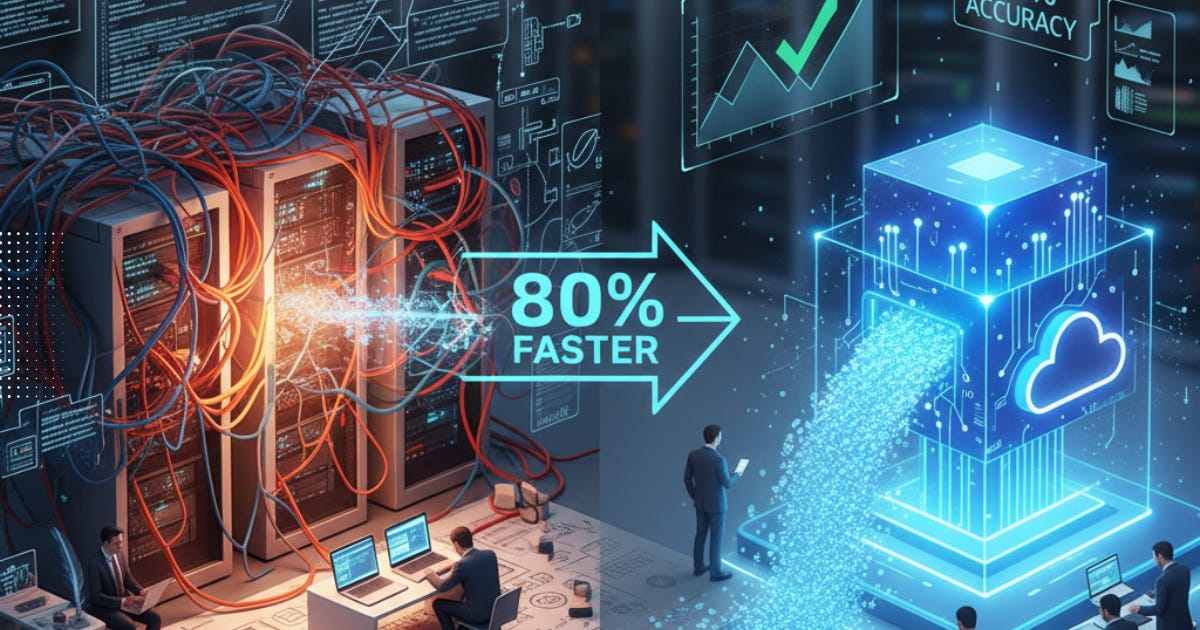#038 - Migrations are now 5x faster. Here's how
Forget hype. We're breaking down the industry data that proves a new AI tool can reduce migration workloads by 80%
Hey there,
Recent research indicates that AI-powered migration tools are significantly more effective than just marketing hype. These tools are actively changing the way data migration happens.
Moreover, recent analyses indicate that they can reduce the need for IT specialists to handle routine migration tasks by about 45%. These developments signal promising progress in the field.
Meanwhile, early adopters report cutting migration timelines by 5-10x compared to traditional manual approaches.
The evidence is clear: intelligent automation is replacing the era of hard-coded migration logic.
Here's what the research reveals:
How AI automation is eliminating the bottlenecks that cause 70% of migration delays
Performance benchmarks from organisations using these tools in production
Which platforms are leading the automation revolution based on capability analysis
Let's dig into the data.
If you're evaluating modern approaches to complex legacy migrations, then here are the research sources you need to understand what's actually working in 2025:
Weekly Resource List:
AI Data Migration Technology Review (10 min read): Comprehensive analysis of how LLMs parse legacy code and the 45% reduction in manual IT specialist tasks
2025 Data Migration Trends Report (7 min read) Industry research on the shift from manual SQL rewriting to AI-powered automation across enterprise organisations
Snowflake Migration Automation Study (5 min read) Platform analysis covering Oracle, SQL Server, and Teradata conversion capabilities with real performance metrics
Beyond the Hype: 3 Proven AI Wins for Data Migration
Industry analysis reveals that most data platform migrations fail not due to technical complexity, but because of the massive manual effort required to convert decades of legacy code.
Here's what the research shows about intelligent automation:
1. Automated Code Translation Delivers Measurable Time Savings
Research from migration tool vendors indicates that AI-powered SQL translation can eliminate 70-90% of manual conversion work.
These systems work by:
Parsing source code into Abstract Syntax Trees (AST)
Using Large Language Models trained on massive codebases
Generating semantically equivalent target code automatically
The performance data is compelling:
Organisations using SnowConvert AI convert hundreds of stored procedures in days, not months
AI tools handle complex procedural logic, cursor operations, and exception management
Independent analysis shows consistent superiority over manual conversion in speed and accuracy
A case study by a telecommunications company documented reducing the Oracle-to-BigQuery conversion time from 4 months to 3 weeks by utilising automated translation tools.
That's an 85% time reduction with improved accuracy compared to manual processes.
2. Continuous Validation Systems Eliminate Post-Migration Surprises
Research identifies data integrity verification as the highest-risk factor in platform migrations.
The problem with traditional methods:
Manual validation catches only 60-70% of data discrepancies
Most issues are discovered post-go-live when fixes are expensive
Teams rely on "hope and pray" validation approaches
AI-powered validation changes the game:
Platforms like Datafold perform value-level comparison between source and target systems
Achieve 99.9% accuracy in discrepancy detection
Continuously refine code translations until perfect data parity is achieved
What this catches that manual testing misses:
Subtle rounding differences in financial calculations
Timezone handling edge cases
Null value processing inconsistencies
Organisations report increased stakeholder confidence and measurably reduced post-migration support costs.
3. Machine Learning Systems Show Exponential Improvement Curves
Unlike static conversion tools with predefined rules, research indicates that AI migration platforms enhance performance with each project.
How the learning works:
Systems learn from compilation errors and validation results
Successful pattern recognition gets incorporated into future translations
Organisation-specific coding patterns become part of the AI's knowledge base
The compound performance gains:
Organisations see 20-30% faster migration times on subsequent projects
One financial services case study documented five separate legacy migrations
Each subsequent project required 25% less time than the previous one
The long-term effect is significant: organisations that adopt AI migration tools early build institutional knowledge within the platform that accelerates all future modernisation efforts.
That's it.
Here's what the research tells us:
AI-powered SQL translation eliminates 70-90% of manual conversion work, with documented case studies showing months reduced to weeks
Continuous validation achieves 99.9% accuracy in detecting data discrepancies, compared to 60-70% for traditional methods.
Machine learning systems deliver 20-30% faster performance on subsequent migrations as they learn organisational patterns.
The organisations embracing these tools aren't just adopting new technology; they're gaining measurable competitive advantages in modernisation speed and reliability.
Begin your evaluation by benchmarking one of these AI conversion tools against your current manual processes. The performance data suggests you'll quickly understand why traditional approaches are becoming obsolete.
PS...If you're enjoying this newsletter, please consider referring this edition to a friend. They'll receive weekly insights, backed by industry research, on making data modernisation more predictable and profitable.
And whenever you're ready, there are 3 ways I can help you:
Migration Readiness Assessment & Roadmap - The essential first step to clarity. Fixed-fee, 3-4 week engagement for leaders who need a comprehensive architectural blueprint and de-risked plan before committing to full-scale legacy data migration.
Fractional Data Architect Retainer - Ongoing senior architectural leadership to guide your team through major projects. Consistent expert oversight that ensures design integrity, manages technical risk, and keeps complex initiatives aligned with core business goals.
Advisory & Review Sessions - Expert guidance on demand. Prepaid hours are ideal for reviewing internal plans, evaluating vendor proposals, or workshopping specific architectural challenges with a seasoned expert who has over 15 years of experience in the field.


